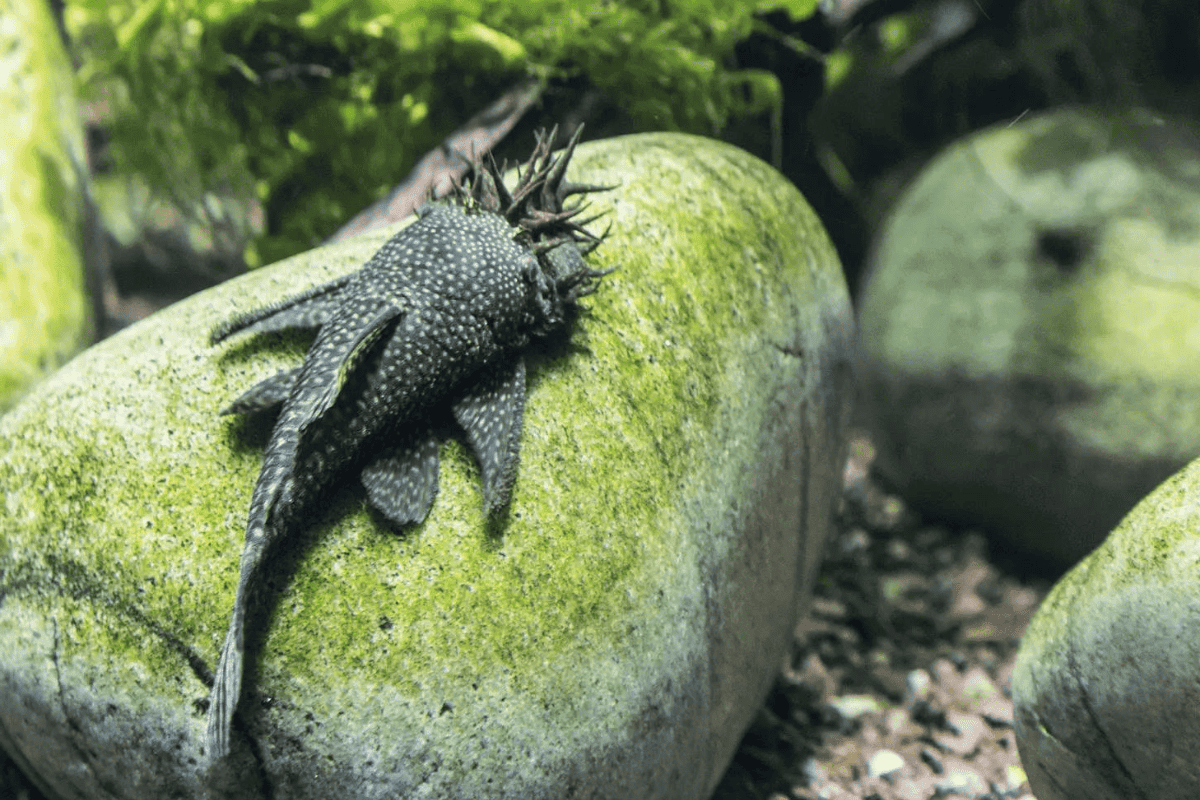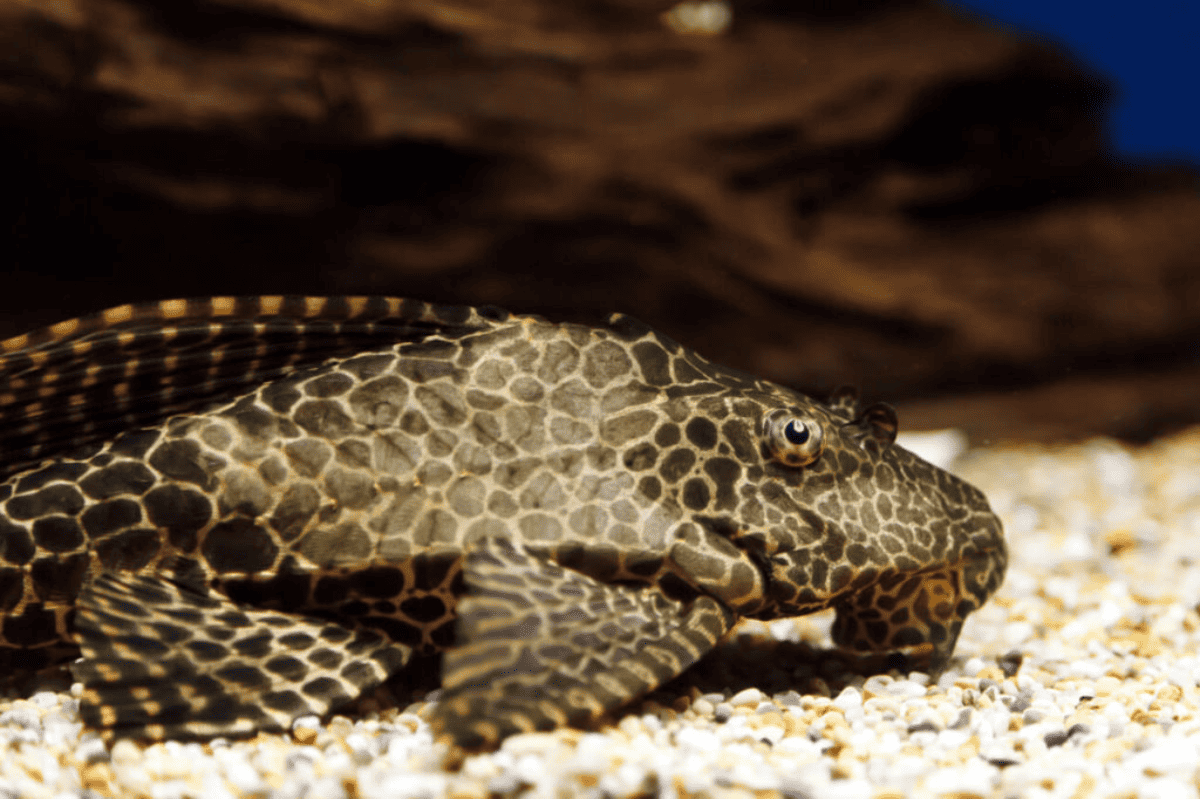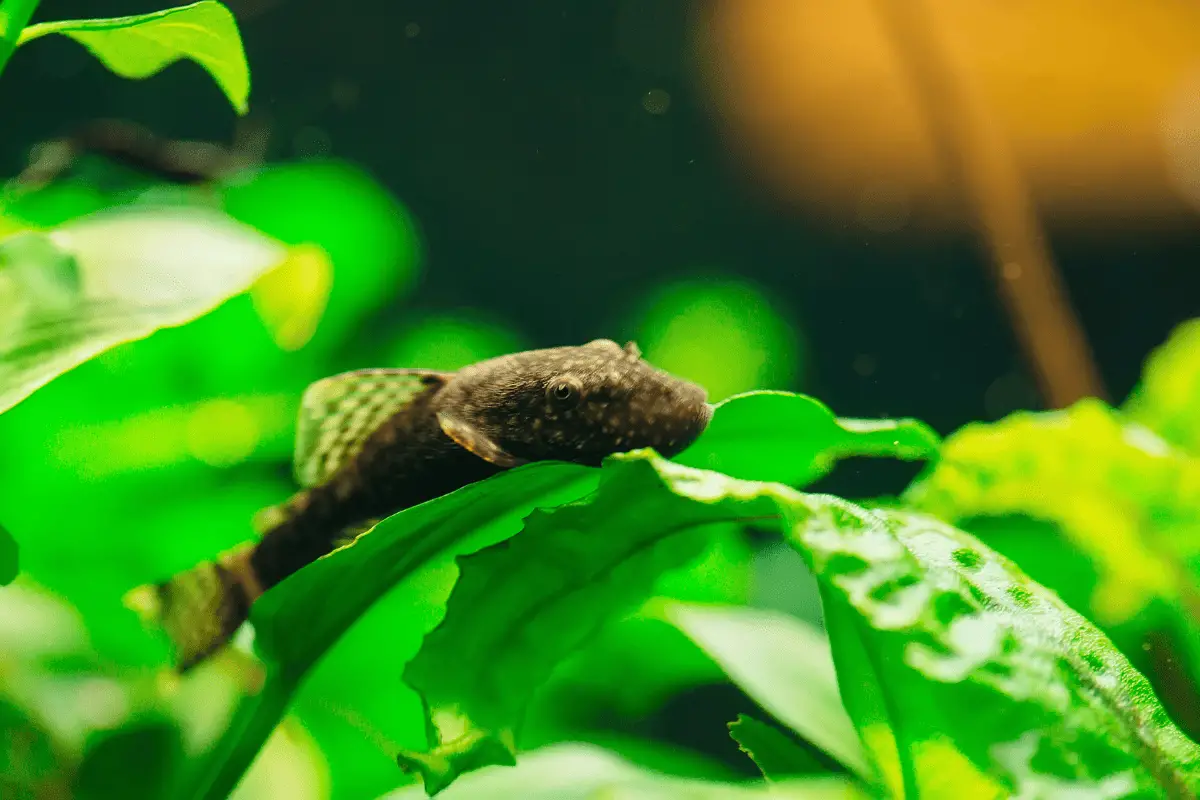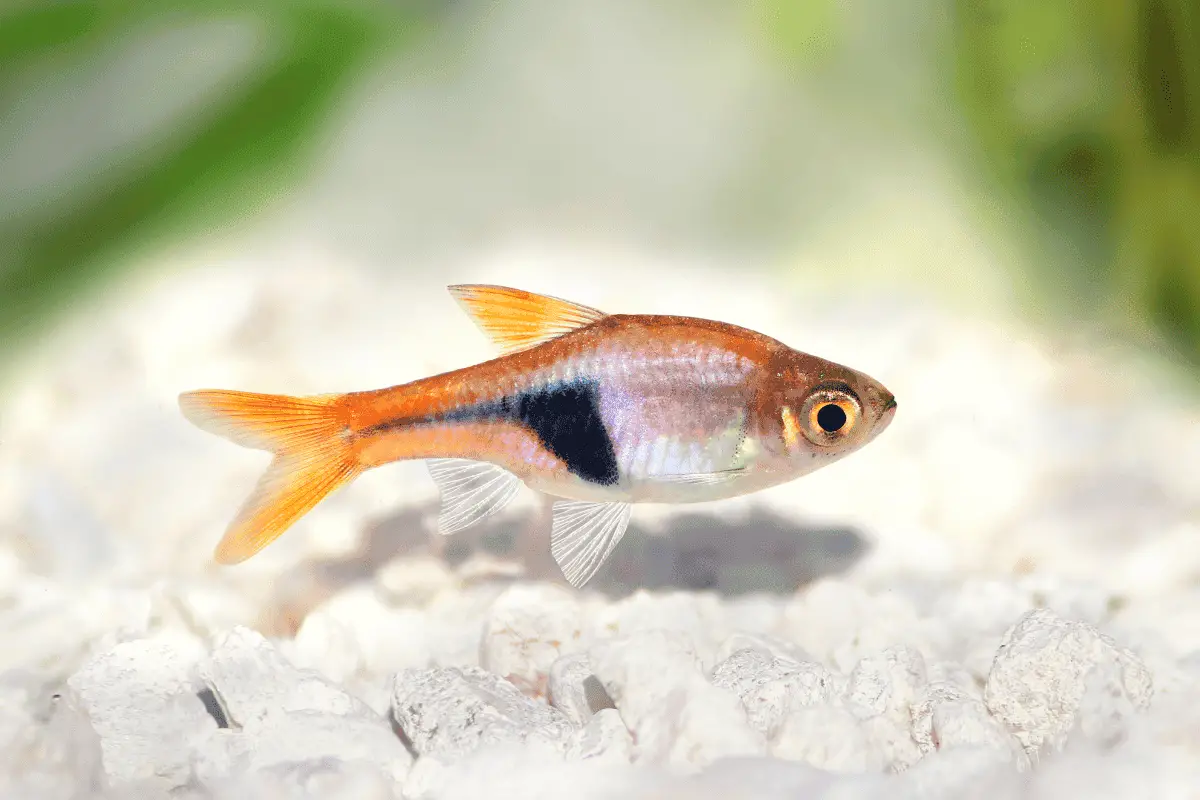Plecos and Dwarf Gouramis are both favored picks for freshwater fish enthusiasts. But is it feasible for them to coexist in a shared environment?
What should you weigh in when wanting them to share a home? How about their habitat needs, water specifications, and dietary routines?
Which varieties of Plecos fit well in such a blend, and which ones are best left out? And then there’s the question of other possible tank companions.
In this article, I’ll answer all these questions and more, so you leave with all the information you need. Let’s get stated.

Can I Keep Plecos and Dwarf Gouramis Together in the Same Tank?
Yes, Plecos and Dwarf Gouramis can live together in the same tank. Their compatibility stems from distinct behaviors and needs:
- Distinct Habitats: Plecos are bottom-dwellers, focusing on the tank’s substrate. Dwarf Gouramis swim in the upper and middle regions, minimizing territorial disputes.
- Varied Diets: While Plecos primarily consume algae and detritus, Dwarf Gouramis prefer small insects and larvae, meaning they don’t compete for food resources.
- Non-aggressive Nature: Both species are known for their generally peaceful temperament, ensuring that neither will typically provoke the other.
- Similar Water Conditions: Plecos and Dwarf Gouramis both thrive in similar pH ranges and water temperatures, making tank parameter adjustments simpler.
- Decor Enthusiasts: Plecos often appreciate driftwood for rasping, while Dwarf Gouramis enjoy planted environments. A well-decorated tank benefits both.
Also Read: Pleco Fish Tank Mates
Plecos vs. Dwarf Gouramis: Behavior
The first factor worth considering is the Plecos’ and Dwarf Gouramis’ natural behavior. Here is what you should know:
1. Pleco Fish: Natural Behavior
Plecos are fascinating fish known for their unique bottom-dwelling behaviors and dietary preferences.
Often seen suctioned to surfaces, they are primary scavengers and algae eaters.
- Nocturnal Nature: Plecos tend to be more active during the night, coming out from their hiding spots to forage and feed.
- Surface Suckers: Using their specially adapted mouths, Plecos often attach to surfaces, especially glass, feeding on algae and biofilm.
- Hiding Habit: Plecos are known to seek out hiding spots, like caves or under driftwood, to feel secure and avoid stress.
- Gentle Giants: Despite their potential size (some species can grow up to 24 inches), most Plecos are non-aggressive and coexist well with other species.

2. Dwarf Gouramis: Natural Behavior
Dwarf Gouramis are colorful, top and mid-level swimmers with interesting behaviors, particularly related to breeding.
Their vibrant colors and patterns often make them the stars of a tank.
- Bubble Nest Builders: Males build bubble nests at the water’s surface, a unique breeding behavior where they protect and oxygenate eggs.
- Shy Swimmers: Dwarf Gouramis can be a bit timid, often seeking the shelter of plants or decorations when startled.
- Surface Breathers: They possess a labyrinth organ, allowing them to gulp air directly from the surface, especially in low-oxygen conditions.
- Interactive Fish: These Gouramis are known to recognize their caregivers and can even be trained to eat from one’s hand.

Ideal Parameters for Plecos and Dwarf Gouramis
When maintaining a healthy aquarium, understanding the ideal water parameters for each fish type is crucial.
Here’s a comparison of the parameters preferred by Plecos, Dwarf Gouramis, and what’s best when both fish types cohabit:
| Parameter | Plecos | Dwarf Gouramis | Both Types |
| Temperature | 74-80°F (23-27°C) | 77-78.5°F (25-25.8°C) | 76-78°F (24.4-25.5°C) |
| pH Level | 6.5-7.5 | 6.0-7.5 | 6.5-7.5 |
| Water Hardness | Up to 15 dGH | 4-10 dGH | 5-12 dGH |
1. Pleco Fish: Ideal Parameters
Plecos, being tropical freshwater fish, require specific water conditions to thrive. Maintaining these parameters ensures their health and longevity.
- Temperature Range: Plecos prefer a temperature range of 74-80°F (23-27°C), though specifics can vary based on species.
- pH Levels: A pH range of 6.5 to 7.5 is generally ideal, ensuring a slightly acidic to neutral environment.
- Water Hardness: Plecos thrive in soft to moderately hard water, typically between 4-15 dGH.

2. Dwarf Gouramis: Ideal Parameters
Dwarf Gouramis, native to freshwater environments in Asia, have slightly different requirements, though there’s overlap with Plecos.
- Temperature Needs: Dwarf Gouramis enjoy temperatures between 77-82°F (25-28°C), slightly warmer than some Plecos.
- pH Preferences: A pH of 6.0 to 7.5 is best for these fish, allowing a mildly acidic to neutral water condition.
- Water Hardness: Like Plecos, they prefer soft to moderately hard water, with a range of 4-10 dGH being optimal.

Plecos vs. Dwarf Gouramis: Tank Setup
Setting up a tank appropriately ensures the well-being of its inhabitants.
Compare the requirements of Plecos and Dwarf Gouramis, along with considerations for a tank housing both:
| Setup Item | Plecos | Dwarf Gouramis | Both Types |
| Ammonia Nitrite Nitrate | 0ppm/0ppm/<20ppm | 0ppm/0ppm/<20ppm | 0ppm/0ppm/<20ppm |
| Tank Size | Minimum 55 gallons | 20-30 gallons | Minimum 55 gallons |
| Foliage | Prefers plenty of plants | Loves densely planted areas | Dense plantings required |
| Decorations | Loves caves & hiding spots | Appreciates hiding spots | Caves & ample hideouts |
| Filter | Strong filtration needed | Moderate filtration | Strong filtration system |
| Heater | Needed for stable temperature | Essential for warmth | Consistent heating needed |
| Substrate | Prefers sand or soft substrate | Fine substrate preferred | Fine sand or soft substrate |
| Pump | Requires good circulation | Moderate flow preferred | Balanced flow |
| Lighting | Moderate to low | Low to medium | Moderate lighting |
1. Pleco Fish: Tank Setup
Plecos, due to their potential size and unique behaviors, require specific conditions for optimal health and happiness. Setting up a tank tailored to their needs ensures they thrive.
- Ammonia Nitrite Nitrate: For Plecos, maintaining undetectable levels of ammonia and nitrite, and nitrates below 20ppm, is crucial.
- Tank Size: A minimum of 55 gallons is recommended for many Plecos, though larger species demand tanks of 100+ gallons.
- Foliage: Plecos don’t need extensive foliage, but some plants can provide additional hiding spots.
- Decorations: Cave-like structures or driftwood are essential, offering Plecos places to hide and rasp on.
- Filter: A powerful filter, preferably a canister type, is essential due to the waste Plecos produce.
- Heater: A consistent temperature, best achieved with a reliable heater, is vital for Plecos’ tropical needs.
- Substrate: Soft, sandy substrates can be beneficial, but they’re also fine with gravel.
- Pump: Adequate water circulation, achievable with a quality pump, assists in mimicking their natural environment.
- Lighting: Moderate lighting suits Plecos, but ensure there are shaded areas or hiding spots.

2. Dwarf Gouramis: Tank Setup
Dwarf Gouramis are visually striking fish with specific habitat preferences, primarily stemming from their native Asian freshwater environments.
- Ammonia Nitrite Nitrate: Like Plecos, Dwarf Gouramis need ammonia and nitrite at zero and nitrate levels under 20ppm.
- Tank Size: A minimum of 20 gallons is suitable for a pair of Dwarf Gouramis.
- Foliage: Thick plantations are preferable, as they mimic their natural habitats and offer hiding spaces.
- Decorations: Gentle decorations without sharp edges are ideal, given the Gouramis’ delicate fins.
- Filter: A gentle filtration system that doesn’t create strong currents, accommodating their calmer waters, is recommended.
- Heater: Dwarf Gouramis also require a heater to maintain a consistent tropical temperature.
- Substrate: Soft substrates, like fine sand or small pebbles, are ideal for Gouramis.
- Pump: A mild water circulation pump is best, replicating the calm waters they’re accustomed to.
- Lighting: Moderate to low lighting complements Dwarf Gouramis, highlighting their vibrant colors and supporting plant life.

The Dietary Requirements of Plecos and Dwarf Gouramis
Diet plays a pivotal role in the health of your fish. Let’s break down the dietary needs of Plecos, Dwarf Gouramis, and recommendations for tanks with both:
| Dietary Aspect | Plecos | Dwarf Gouramis | Both Types |
| Food Types | Algae wafers, veggies, pellets | Omnivore flakes/pellets | Varied diet, include both |
| Quantity | Varies with size/age | 2-3 small pinches daily | Adjust as per individual needs |
| Feeding Schedule | Daily to every other day | 1-2 times daily | Monitor and adjust accordingly |
1. Pleco Fish: Ideal Dietary Requirements
Plecos have a varied diet, heavily reliant on algae and other vegetable matter. Supplementing their diet ensures they receive all essential nutrients.
- Food Types: Algae wafers, spirulina tablets, and occasional fresh veggies (like zucchini) are Pleco staples.
- Quantity: Plecos can eat a significant amount due to their size; adjust based on the fish’s girth and waste production.
- Feeding Schedule: Daily feeding, with occasional fasting days, helps in digestion and ensures Plecos don’t overeat.

2. Dwarf Gouramis: Ideal Dietary Requirements
Dwarf Gouramis are omnivorous and require a balanced diet of plant and protein sources for vibrant health and colors.
- Food Types: They enjoy high-quality flakes, small pellets, live foods (like brine shrimp), and occasional veggies.
- Quantity: Feed enough that Gouramis can consume in 2-3 minutes to prevent overfeeding and tank contamination.
- Feeding Schedule: Feeding them once or twice daily, ensuring all food is consumed, maintains optimal health.

Pleco Species Most Suitable for a Tank With Dwarf Gouramis
When considering a Pleco species to pair with Dwarf Gouramis, it’s best to opt for smaller, non-aggressive Plecos.
The following species are particularly well-suited for tanks with Dwarf Gouramis:
- Bristlenose Plecos (Ancistrus spp.): Reaching only about 4-6 inches, they’re an ideal size and have a peaceful nature.
- Clown Plecos (Panaqolus maccus): Staying under 4 inches, their compact size and affinity for driftwood make them great tank mates.
- Rubber Lip Plecos (Chaetostoma formosae): Growing to 7 inches, they’re relatively small and harmoniously coexist with Gouramis.
- Zebra Plecos (Hypancistrus zebra): A sought-after species that remains below 4 inches and exhibits a calm demeanor.
- Butterfly Pleco (Dekeyseria brachyura): Often growing to about 7 inches, they’re non-aggressive and can thrive alongside Gouramis.
Also Read: Can Plecos And Loaches Live Together?

Which Pleco Types Shouldn’t Be Kept with Dwarf Gouramis?
While many Plecos get along well with Dwarf Gouramis, certain species can pose challenges due to their size or temperament. It’s essential to be wary of the following:
- Common Plecos (Hypostomus plecostomus): Often growing over 12 inches, their size and activity might stress Dwarf Gouramis.
- Sailfin Plecos (Pterygoplichthys gibbiceps): Their large size, often reaching 18 inches, can make the tank environment unsuitable for smaller fish like Gouramis.
- Royal Plecos (Panaque nigrolineatus): Reaching up to 17 inches, their size and wood-chomping habits may disrupt a Gourami-friendly setup.
- Gulper Pleco (Acanthicus adonis): Their massive size, sometimes over 30 inches, and aggressive nature make them unsuitable with Gouramis.
- Rhino Pleco (Pterygoplichthys scrophus): Growing up to 20 inches, their substantial presence and territorial behavior can intimidate Dwarf Gouramis.
How to Introduce Your Pleco to a Tank with Dwarf Gouramis
Introducing your Pleco to a tank with Dwarf Gouramis demands a systematic and cautious approach. This will ensure both fish types coexist without undue stress or conflict.
- Acclimate Properly: Float the Pleco’s sealed bag in the tank for 45 minutes, gradually adding 1/4 cup of tank water every 10 minutes.
- Monitor Water Parameters: Confirm 0ppm ammonia, 0ppm nitrite, and below 20ppm nitrate levels using a reliable test kit.
- Introduce During Feeding: Feed Gouramis before the Pleco’s release, diverting their attention and reducing initial territorial disputes.
- Use a Quarantine Tank: Keep the Pleco in a separate quarantine tank for 2 weeks to ensure it’s disease-free.
- Observe Behavior: After introducing, closely watch for any signs of aggression or stress for the first 72 hours.

Tips for Keeping Plecos with Dwarf Gouramis
For harmonious tank cohabitation between Plecos and Dwarf Gouramis, certain guidelines can prove invaluable. Following these tips can ensure both species thrive.
- Tank Size Matters: Opt for at least a 55-gallon tank to ensure ample space for roaming and territory establishment.
- Maintain Hideouts: Integrate cave structures and driftwood, offering Plecos personal retreats, reducing stress. My recommendation: Dr. Moss Malaysian Driftwood (link to Amazon).
- Monitor Feeding Zones: Drop Pleco-specific food near its hideout and Gourami food at the tank’s surface.
- Weekly Water Changes: Replace 20-25% of tank water weekly to maintain optimal water quality and parameters.
- Avoid Overcrowding: Limit the number of inhabitants; too many fish can lead to territorial issues and increased waste.
- Regular Health Checks: Keep an eye out for symptoms of illnesses such as ich or fin rot. Early detection and treatment are key.
- Ensure Proper Filtration: Use a strong filtration system to manage waste from both Plecos and Gouramis, fostering a healthier habitat. I personally got the Fluval C4 Power Filter (link to Amazon).
Best Tank Mates for Plecos and Dwarf Gouramis
When creating a community tank that includes Plecos and Dwarf Gouramis, it’s crucial to pick tank mates that are a good match in both temperament and environmental needs.
There are several fish species that can live happily with Plecos and Dwarf Gouramis, contributing to a balanced aquatic community.
- Corydoras Catfish: These peaceful bottom dwellers are excellent for cleaning the tank floor and won’t bother Plecos or Gouramis.
- Tetras (like Neon and Cardinal): These small, schooling fish add vibrant colors and primarily swim in the middle to upper areas of the tank, which complements both species.
- Mollies and Platies: These easy-going livebearers are versatile and non-aggressive, making them great for a mixed community.
- Harlequin Rasboras: Their gentle nature and eye-catching looks make them both compatible and visually appealing.
- Snails (such as Nerite and Mystery): Helpful for controlling algae, snails live peacefully with Plecos and Gouramis without competing for food.
- Cherry Barbs: These small, non-aggressive fish are a solid choice, just be sure to maintain a balanced gender ratio.
Also Read: Can Plecos And Barbs Live Together?

Conclusions
For those skimming, here’s a quick summary:
- Plecos and Dwarf Gouramis get along well in the same tank because they have different behaviors, eating habits, and are generally peaceful.
- Knowing the right conditions, tank setups, and food is essential for their well-being when housed together.
- It’s important to choose appropriate Pleco types like Bristlenose or Clown Plecos and steer clear of larger or more aggressive ones.
- When adding Plecos to a tank with Dwarf Gouramis, careful acclimation and close monitoring are key to avoiding issues.
- Maintaining the right tank size, hiding spots, water quality, and choosing compatible buddies like Corydoras Catfish and Tetras help ensure a thriving community with these fish.
